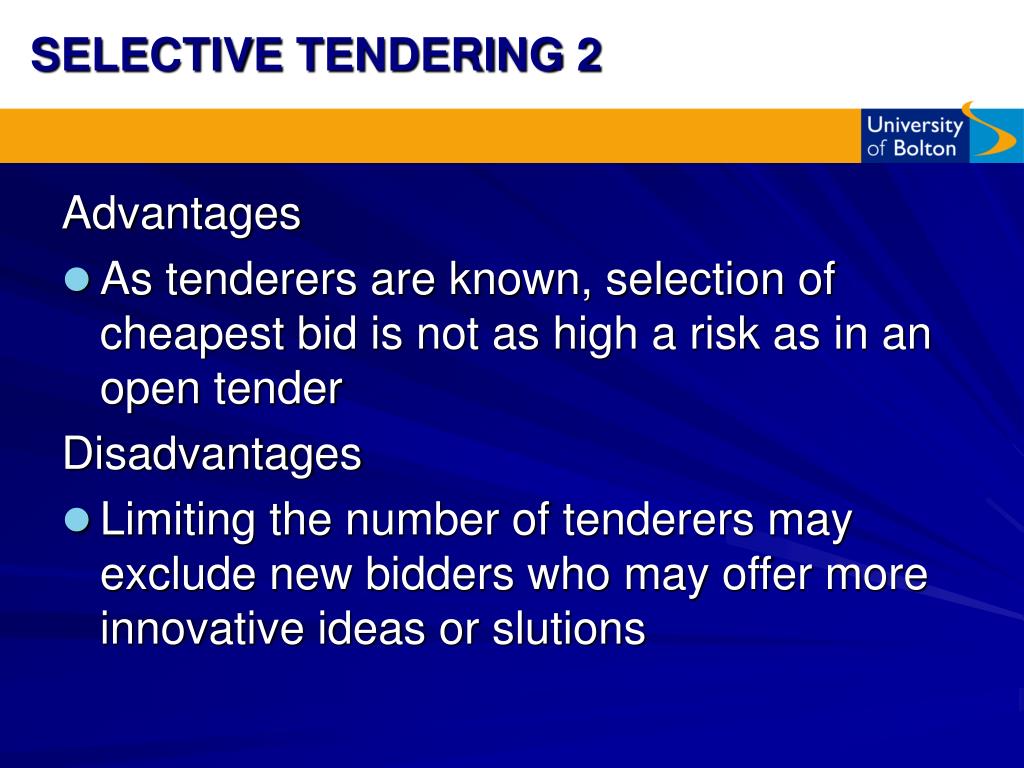Selective tendering is a procurement process in which an organization invites a limited number of pre-selected contractors or suppliers to bid on a project or supply goods or services. This method is used when an organization wants to carefully consider the qualifications and capabilities of potential contractors or suppliers before inviting them to participate in the bidding process.
There are several reasons why an organization might choose to use selective tendering. One reason is that the organization has specific requirements for the project or goods and services that can only be met by a limited number of potential contractors or suppliers. In this case, selective tendering allows the organization to ensure that the contractors or suppliers invited to participate in the bidding process are capable of meeting the specific requirements of the project.
Another reason for using selective tendering is to reduce the risk of awarding the contract to a contractor or supplier who is not capable of completing the work to the required standards. By carefully selecting the contractors or suppliers who are invited to participate in the bidding process, the organization can minimize the risk of selecting a contractor or supplier who is not capable of delivering the project to the required standards.
Selective tendering can also be used to improve the overall quality of the work performed by contractors or suppliers. By carefully selecting contractors or suppliers who have proven track records of delivering high-quality work, the organization can increase the chances of a successful project outcome.
There are some drawbacks to using selective tendering, however. One disadvantage is that it can be time-consuming to carefully evaluate the qualifications and capabilities of potential contractors or suppliers before inviting them to participate in the bidding process. Additionally, selective tendering can be less cost-effective than other procurement methods, as it may result in fewer bids being received and a less competitive bidding process.
Overall, selective tendering is a procurement process that allows an organization to carefully consider the qualifications and capabilities of potential contractors or suppliers before inviting them to participate in the bidding process. While it may be more time-consuming and less cost-effective than other procurement methods, it can help to reduce risk and improve the overall quality of work performed.
Trade agreements tendering approaches

Each Contractor will evaluate their current commitments and project details before confirming their participation. What is selective tendering? After a stringent evaluation process, they will select the few most relevant parties to submit their bids. Selective tendering sometimes known as restricted tendering is a bidding process where only certain vendors can bid for the project. Yet, there are certain disadvantages that come with selective tendering. In some cases, the prequalification process can come before the Request for expression of interest. If any contractor cannot match the minimum required benchmark in the technical proposal, they will be disqualified without moving to commercial evaluation.
What is selective tendering?

In this example, the school is the Buyer and the cleaning company is the Supplier. A response from potential suppliers to a notice of planned procurement is not required. Why do people tender? However, note that each type of request can differ in terms of the documents required and the outcome of the request. You may have heard the term selective tendering bandied about by buyers and vendors alike. This method of tendering is usually used when there are a number of similar projects taking place, for example a series of schools being built. Share this: Facebook Facebook logo Twitter Twitter logo Reddit Reddit logo LinkedIn LinkedIn logo WhatsApp WhatsApp logo The method of single stage selective tendering involves finding contractors, possibly from previous experience, and asking them to submit tenders for the project at hand.
What Is Selective Tendering In Construction?

Two-Stage Tendering In the first stage, suitable contractors will be selected by evaluating their pre-qualification parameters Past Experience, Strength of Resources, Financial Capabilities, etc. Specifically, these will be vendors that the buyer has personally invited to vie for the contract. Is it different from an RFT? Two-stage selective tendering The two-stage selective tendering process is used when the client needs additional support at the. For Example, if a client chose a contractor based in the UK to carry out works in northern Scotland the tender price will be significantly higher. This enables the contractor to get a quicker idea of price ranges for the other projects as he already knows what he is expecting.
Tendering Process:Advantages and Types, All You Need to Know

If the client wants to verify submitted documents thoroughly, they may physically visit previously completed projects, factory facilities and office facilities. Selective tendering is sometimes referred to as restricted tendering. Some sites are contaminated which will result in a massive operation to decontaminate the site and a massive increase in tender pricing. The deposit is refunded, or the bond is released on the submission of a bona fide tender. Given that the supplier and tenderer are acquainted with each other and their work, this can benefit the tendering process by decrease the duration and cost of the exchange.
What is Selective Tendering?

This is because buyers are likely to choose suppliers that have a track record of success or relevant It could also reduce the potential for innovation, as suppliers are unable to present new ideas to the buyer. You run a Civil Construction company capable of doing the work they want, so you submit a tender also referred to as a tender response, bid, or proposal which outlines how you would meet their requirements and how much it would cost. In the second meeting it is likely the contractors will bring bills of quantities to submit as part of the final tender. Therefore, types of tendering are used to choose the most suitable contractor for the project. The short answer is yes, a tender is different from an RFT.
Altura

In the second stage, negations will be carried out with the selected contractors and finalize the contractor, who is getting the award of the contract. These firms generally have a track record that signifies competence for similar projects e. Most of these authorities register and categorise firms, and the client can select based on project criteria. And the client will assess the technical proposal and commercial proposal separately. In some projects, the client may ask the Contractor to sign and submit an NDA non-disclosure agreement along with their expression of interest.






